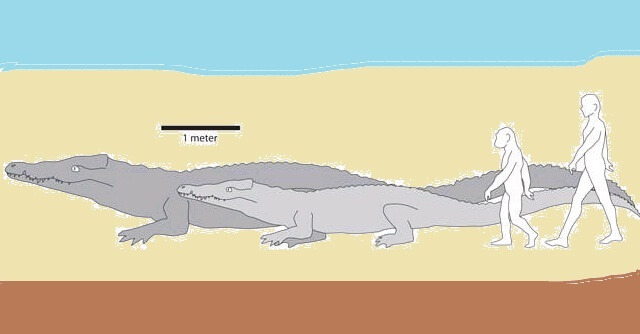According to a researcher at the University of Iowa, the crocodile that lived 2 million years ago in Kenya is not related to the crocodiles of today

A crocodile (crocodile) that was big enough to swallow a man, once lived in East Africa. This is according to a study conducted by a researcher at the University of Iowa. "This is the largest crocodile that ever lived, and known to science. says Christopher Brochow, professor of geological sciences. "He reached a length of 8.25 meters. For comparison, the largest crocodile caught by Napa reached 6.4 meters in length and most of them are much smaller.
Brochu's article on the discovery was published in the Journal of Vertebrate Paleontology. The species that lived 4-2 million years ago in Kenya resembles its living relative, the Alligator, but was much larger. Brochu identified the new species from fossils examined three years ago at the National Museum of Kenya in Nairobi. Some of them were found in areas known for important human fossils that were discovered in them. "This crocodile lived next to our ancestors, and it is possible that it also ate them," said Brucho. He explained that although the findings do not indicate a meeting between a human and a reptile, crocodiles eat everything they can swallow and humans at that time did not exceed a height of 1.10 meters.
"So far we haven't found human remains that suffered crocodile bites, but the crocodiles were bigger than today's and we were smaller, so they probably didn't need to bite." Brochu said.
He added that there were many opportunities for humans to encounter crocodiles because the first humans, as well as other animals, sought water in the rivers and lakes where the crocodiles lay and waited.
As for the name of the species he discovered, Brochow had no doubts. The crocodile Crocodylus thorbjarnarsoni is named after John Thorbjarnarson, a famous crocodilian expert and Brochu's colleague, who died of malaria a few years ago while in the field in Africa. "He was a giant in the field of crocodiles, so it made sense to name a crocodile after him. I miss him and had to honor his memory in some way. I couldn't help but do it.”
The crocodile's fossil head was heavy, it took four people to lift, but other experts saw the fossil without recognizing that it was a new species. Brucho comments that the collection in Nairobi is beautiful and contains many fossils that have not been fully explored, so many discoveries can still be made there."
This is not the first time Brochu has been involved in the discovery of fossils in East Africa. In 2010 he published an article about the discovery of a man-eating crocodile from Tanzania that he called Crocodylus anthropophagus and which is close to the species he discovered this time.
According to him, the new species is not directly related to our present day crocodiles. He believes that the Hior crocodile was a relatively young species and not a living fossil, as many think. "We don't know where the Hior crocodile came from," Brocho said. "But it appeared long after those prehistoric giants had died out.
The research was funded by the National Science Foundation and the Oberman Center for Advanced Research.
